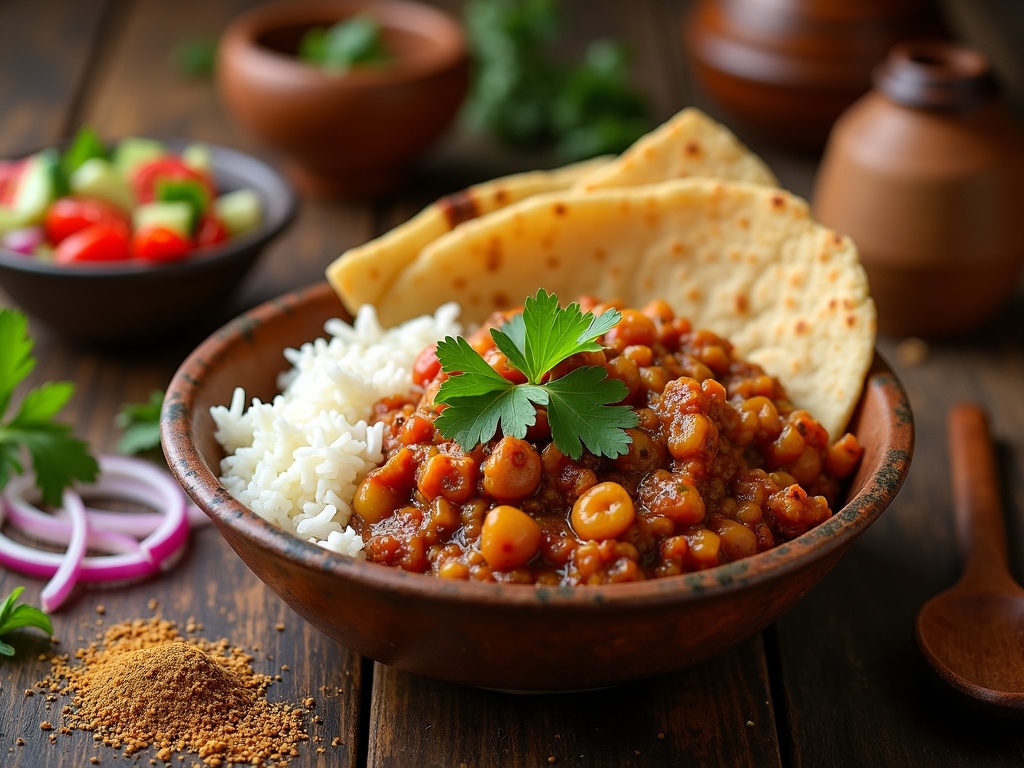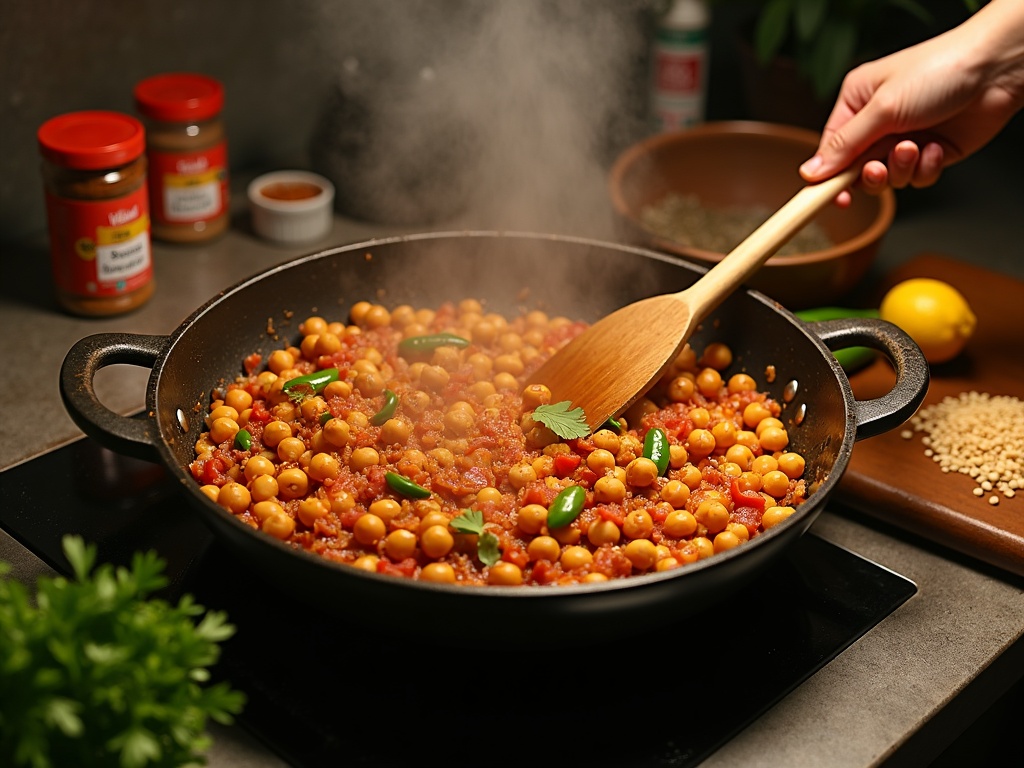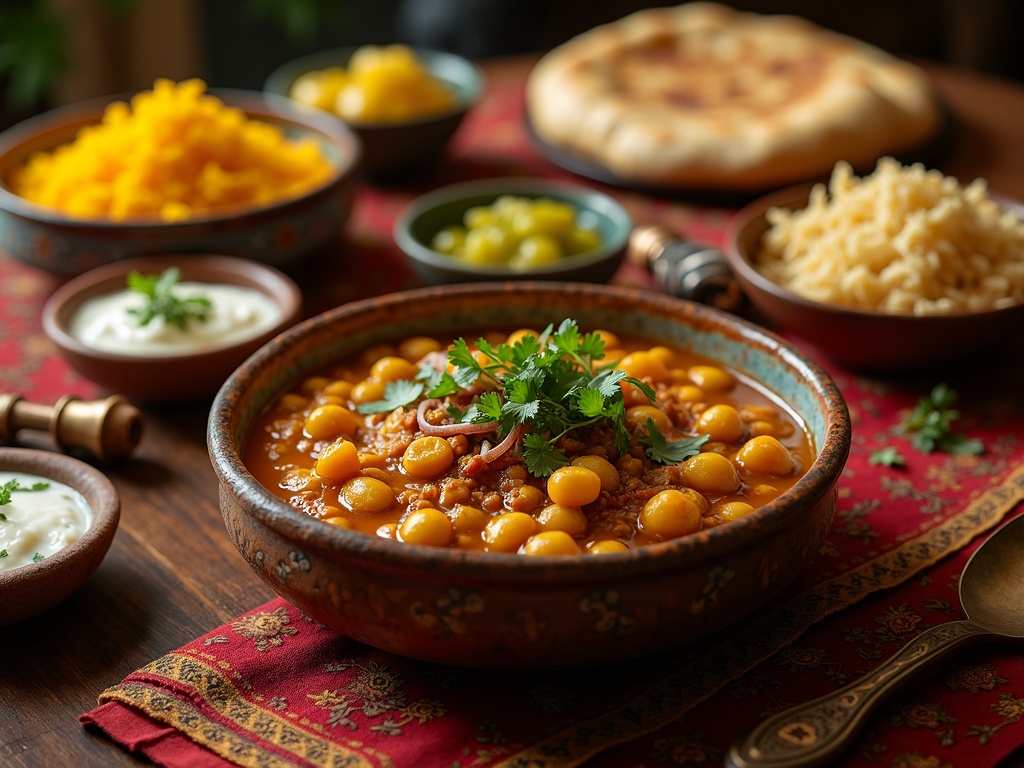Chole recipe, a flavorful chickpea curry, stands as a cornerstone of North Indian cuisine thanks to its perfect balance of spices, impressive nutritional profile, and remarkable versatility. This beloved dish combines protein-rich chickpeas with a complex blend of aromatic spices to create a satisfying meal that has found its way from home kitchens to street food stalls and international restaurant menus.
Find In This Article
Key Takeaways
- Chole offers substantial plant-based protein and fiber, making it an excellent nutritional choice for vegetarians and health-conscious diners.
- The authentic flavor profile comes from a carefully balanced spice blend including cumin, coriander, garam masala, and sometimes amchur (dried mango powder).
- Regional variations like Amritsari Chole (featuring tea bags during cooking) and Dhaba-style Chole highlight India’s diverse culinary traditions.
- The dish pairs traditionally with bhature (fried bread), but also works beautifully with rice, naan, or as part of street food preparations.
- Restaurant-quality results depend on proper texture management, layering spices at different cooking stages, and allowing sufficient simmering time for flavors to develop.
What Makes Chole a Beloved North Indian Dish
Chole has earned its place as one of the most cherished dishes in North Indian cuisine, and for good reasons. This flavorful chickpea curry combines the perfect balance of spices and textures that’s hard to resist. India produces over 1 million tons of chickpeas annually, highlighting the importance of this ingredient in the country’s culinary landscape.
A Nutritional Powerhouse
I’ve found that chole offers an excellent source of plant-based protein, making it a go-to option for vegetarians and vegans alike. The chickpeas that form the base of this dish are packed with essential nutrients, fiber, and complex carbohydrates. For those looking to incorporate more meatless meals into their diet, chole provides a satisfying alternative that doesn’t compromise on flavor or nutrition.
When paired with rice or naan, chole creates a complete protein profile similar to what you’d find in meat-based dishes. This nutritional balance has contributed significantly to its popularity across different regions, especially in a country where vegetarianism has deep cultural roots.
Cultural Significance and Versatility
The cultural importance of chole extends beyond its nutritional benefits. This dish has traveled from home kitchens to become a beloved street food favorite across North India. I’ve noticed how chole has adapted across different regions while maintaining its core characteristics.
In Punjab, chole is often served with bhature (fried bread), creating the famous “chole bhature” combination that’s impossible to resist. Meanwhile, in other regions, you might find it paired with:
- Steamed rice for a simpler, homestyle meal
- Kulcha, a type of leavened bread
- Puris, small deep-fried breads perfect for scooping up the curry
- As part of chaat, a savory snack often found in street food stalls
The dish’s versatility doesn’t end with its pairing options. The spice level can be adjusted to suit individual preferences, making it accessible to both spice enthusiasts and those with milder palates. Some versions incorporate rich onion gravy for depth, while others focus on a tomato-based sauce.
What started as a regional specialty has now found its way onto restaurant menus worldwide, showcasing the global appeal of this humble yet flavorful legume-based dish. Its ability to satisfy and nourish while delivering complex flavors makes chole a true standout in the diverse world of Indian cuisine.
Power-Packed Health Benefits You Should Know
Chickpeas, the star ingredient in chole, pack an impressive nutritional punch that makes this dish more than just a flavorful meal. I’ve discovered that incorporating chole into my regular diet has significant health advantages worth highlighting.
Nutritional Powerhouse
The nutritional profile of chickpeas is truly remarkable. One cup provides 12.5 grams of dietary fiber, which meets approximately 50% of your daily recommended intake. This high fiber content helps regulate digestion, keeps you feeling full longer, and can assist with weight management goals. When I prepare lentil and chickpea dishes regularly, I notice improved digestive health and more consistent energy levels throughout the day.
Protein content is another major benefit, especially for those following vegetarian or plant-based diets. Chickpeas offer a substantial protein boost, making chole an excellent option for muscle maintenance and growth. I’ve found that adding this hearty vegetable curry to my meal rotation helps meet my protein needs without relying on animal products.
Iron deficiency is common worldwide, but chickpeas can help address this issue. With 4.7 mg of iron per cup, chole contributes significantly to your daily requirements. This mineral is essential for transporting oxygen throughout your body and maintaining healthy energy levels. Pairing chole with vitamin C-rich foods enhances iron absorption, making it even more effective.
Folate content in chickpeas deserves special mention. This B vitamin plays a critical role in cell division and DNA synthesis, making it particularly important during pregnancy and for overall cellular health. Adding protein-rich Indian dishes like chole to your diet can help ensure adequate folate intake.
The overall plant-based nutrition profile of chole makes it a standout dish. Here’s what makes chickpeas an excellent addition to your diet:
- Contains essential minerals including manganese, copper, and zinc
- Provides antioxidants that fight inflammation and oxidative stress
- Offers complex carbohydrates for sustained energy release
- Contains choline, important for brain and nervous system function
- Supports heart health with potassium and magnesium
I’ve noticed that incorporating chole into my meal plan about twice a week has made a noticeable difference in my energy levels. The combination of protein and complex carbs creates a balanced meal that prevents the energy crashes often associated with refined carbohydrates.
What makes chole particularly special is how it combines these nutritional benefits with incredible flavor. Unlike bland health foods that require sacrifice, this rich Indian curry delivers both taste and nutrition. The spices used in traditional chole recipes—like cumin, coriander, and garam masala—add their own health benefits, including anti-inflammatory properties and digestive support.
For those concerned about blood sugar management, chickpeas have a low glycemic index, meaning they cause a slower, more gradual rise in blood sugar compared to many other carbohydrate sources. This makes chole a smart choice for maintaining steady energy and supporting healthy blood sugar levels.
The versatility of chole also makes it practical for everyday nutrition. I can prepare a large batch and enjoy it throughout the week, paired with rice, roti, or even as a topping for baked potatoes. This convenience factor makes it easier to consistently benefit from its nutritional profile without spending hours in the kitchen for each meal.
When I’m looking for a meal that satisfies both my taste buds and nutritional needs, chole consistently delivers. Its rich, aromatic savory gravy and hearty texture make it a favorite comfort food that I don’t have to feel guilty about enjoying regularly.

Essential Ingredients for Perfect Chole
I’ve found that creating authentic chole starts with gathering the right ingredients. This classic North Indian chickpea curry relies on a perfect balance of spices and fresh components to achieve its distinctive flavor profile.
Core Ingredients List
The foundation of any good chole recipe begins with quality chickpeas. Here are the essential components you’ll need:
- 2 cups cooked chickpeas (or 1 can) as the protein-rich base
- 2 tablespoons mustard or vegetable oil for sautéing
- 1 large onion, finely chopped for the aromatic base
- 2 tomatoes, diced or puréed for tanginess and body
- 2-3 green chilies, adjusted according to your heat preference
- 1-inch piece of ginger, minced for warmth and flavor
- 2-3 garlic cloves, crushed for depth of flavor
The spice blend is what truly transforms this dish into something special. I always include:
- Cumin seeds for earthy undertones
- Coriander powder for citrusy notes
- Garam masala for complex warmth and fragrance
- Salt to taste
- Fresh cilantro for garnishing
Traditional spice combinations often include additional elements like amchur (dried mango powder), which adds a subtle tanginess that complements the hearty legume base perfectly. I’ve discovered that adding a pinch of asafoetida (hing) enhances the overall flavor profile and aids digestion.
For an authentic touch, consider incorporating tea bags during cooking – a technique used in Punjab that imparts a deep brown color and subtle complexity. The contrast between the spicy rich onion gravy and the tender chickpeas creates a delightful textural experience.
When preparing chole for special occasions, I sometimes add a small amount of dried pomegranate seeds (anardana) which introduces a pleasant sourness. This pairs beautifully with the traditional accompaniments like bhature (fried bread) or steamed rice.
Finding high-quality spices makes a noticeable difference in the final dish. Freshly ground spices release more aromatic compounds than pre-ground versions, giving your homemade curry restaurant-quality depth of flavor.
Step-by-Step Cooking Guide
I start my chole preparation by heating oil in a deep pan over medium heat. Once the oil is hot, I add cumin seeds and let them splutter for about 30 seconds until they release their aromatic fragrance. This simple step creates a foundation of flavor that elevates the entire dish.
Next, I add finely chopped onions to the pan and sauté them until they reach a golden brown color. This usually takes 5-7 minutes, and patience is key here – properly caramelized onions add a sweetness that balances the spices perfectly. After the onions are ready, I add minced ginger, garlic, and green chilies, cooking them for another 2 minutes until their raw smell disappears.
The tomato puree goes in next. I cook it down until the oil begins to separate from the mixture, which signals that the tomatoes have fully cooked and released their acidity. This step typically takes 6-8 minutes of gentle simmering.
Adding Chickpeas and Finalizing
Now comes the star of the show – chickpeas! I add them to the pan along with my spice blend. The key spices for authentic chole include:
- Coriander powder for earthy notes
- Cumin powder for warmth
- Garam masala for complexity
- Red chili powder for heat (adjustable to taste)
- Amchur (dried mango powder) for tanginess
After adding the chickpeas and spices, I pour in about a cup of water and let everything simmer for 10-15 minutes. This allows the flavors to meld together while the gravy thickens to the perfect consistency. I often prepare a lentil dish alongside this for a complete meal.
Just before serving, I garnish with freshly chopped cilantro, which adds a pop of color and freshness. For special occasions, I might also add a squeeze of lemon juice and some finely chopped onions on top.
For the best results, I always soak dried chickpeas overnight before cooking. This not only reduces cooking time but also ensures they’re tender while maintaining their shape. If you’re short on time, you could try making a quick vegetable curry instead, but chole is worth the wait.
One common mistake is overcooking the chickpeas until they become mushy. I’m careful to maintain some texture while ensuring they’re soft enough to absorb the flavors of the spices. The balance of spices is crucial too – I start with smaller amounts and adjust according to taste, especially when preparing a rich curry dish like this one.

Classic Serving Suggestions and Regional Variations
The beauty of chole lies not just in its preparation, but also in how it’s served. I’ve found that the right accompaniments can transform this simple chickpea curry into a memorable feast that captures the essence of Indian hospitality.
Traditional Serving Companions
Chole and bhature form an iconic North Indian combination that’s hard to resist. These fluffy, deep-fried bread discs complement the spicy chole perfectly, creating a balance of textures and flavors that’s become a staple in Indian cuisine. For special occasions or weekend treats, I always recommend this indulgent pairing – there’s nothing quite like tearing off a piece of hot bhature and scooping up the flavorful chole.
For everyday meals or healthier options, aromatic basmati rice with chole provides a lighter yet satisfying alternative. The fragrant rice soaks up the rich gravy beautifully, making each bite delicious without the added calories of fried bread.
To complete the meal, these side dishes enhance the dining experience:
- Raita: A cooling yogurt-based side dish that balances the heat of the chole. Cucumber raita works particularly well.
- Pickles: Mango or lime pickles add a tangy punch that cuts through the richness.
- Sliced onions: Raw onions sprinkled with lemon juice and a dash of salt provide crunch and freshness.
- Fresh green chutney: Made with cilantro and mint, this adds another layer of flavor.
Chole’s versatility extends beyond these traditional pairings. I’ve seen it served with naan, roti, and even as a filling for savory wraps alongside other curries like butter chicken for fusion meals.
Regional differences in chole preparation highlight India’s diverse culinary landscape. Amritsari Chole from Punjab features a darker, spicier gravy with a distinctive tangy note from dried pomegranate seeds and black cardamom. The preparation often includes tea bags during cooking, giving it a unique color and depth of flavor.
Jain Chole caters to those following Jain dietary principles, omitting onions, garlic, and root vegetables. Despite these restrictions, the dish maintains impressive flavor through clever use of asafoetida (hing) and other spices to mimic the depth that onion and garlic typically provide.
Perhaps the most beloved variation is Dhaba-style Chole, served at roadside eateries across North India. This version is characterized by its bold, robust flavors and thicker gravy. Dhaba cooks typically use a heavy hand with garam masala and finish the dish with a generous topping of caramelized onions and fresh cilantro, creating a hearty meal for travelers.
In West Bengal, you might encounter a slightly sweeter version with a touch of garam masala and sometimes even a hint of gur (jaggery) to balance the spices. Meanwhile, in Mumbai’s street food scene, chole is often served as a chaat with crispy puris, yogurt, and tamarind chutney.
Each regional variation maintains the core elements that make chole beloved while adding unique touches that reflect local preferences and available ingredients. What connects them all is the comforting, protein-rich base of chickpeas transformed by carefully balanced spices into something far greater than the sum of its parts.
The best part of exploring these variations is discovering how such a humble ingredient can take on so many delicious forms across different regions of India.

How to Achieve Restaurant-Style Results
The difference between homemade chole and restaurant-style chole often comes down to a few simple techniques. I’ve discovered that the secret to creating that authentic taste and texture lies in understanding some fundamental cooking principles that professional chefs use regularly.
Perfecting Texture and Consistency
The texture of your chole can make or break the dish. One trick I’ve found particularly effective is mashing a small portion of the chickpeas while they cook. This creates a thick, creamy base while still maintaining the integrity of most chickpeas. I typically take a potato masher and gently press down on about 15-20% of the chickpeas after they’ve softened. This technique releases the starch that helps bind the gravy and gives it that authentic restaurant consistency.
Consistency management requires attention throughout the cooking process. I add water gradually rather than all at once, which gives me better control over the final thickness. The ideal curry consistency should coat the back of a spoon but still flow smoothly – not too watery and not too thick. Remember that the gravy will thicken slightly as it cools, so I aim for a slightly thinner consistency when the dish is hot.
The cooking time plays a crucial role in developing the right texture. I cook the chickpeas until they’re tender enough to be easily squished between your fingers but still hold their shape. This typically takes about 25-30 minutes on a medium-low simmer after pressure cooking. If they become too mushy, the dish loses its characteristic texture that makes legume dishes so satisfying.
Balancing spices is an art form in itself. I’ve learned that adding spices in stages yields the most complex flavor profile. I start with whole spices like cumin seeds, bay leaves, and cinnamon in hot oil to create an aromatic base. Then I add ground spices like coriander, cumin, and turmeric halfway through cooking. Finally, I finish with garam masala and a touch of kasoori methi (dried fenugreek leaves) in the last five minutes of cooking to preserve their aromatic qualities.
The depth of flavor in restaurant-style chole comes from patience. After adding all ingredients, I let the dish simmer on low heat for at least 20-30 minutes. This slow cooking allows the spices to bloom fully and the flavors to meld together. This step is what transforms a good chole into an exceptional one with layers of flavor that unfold with each bite.
For that distinctive restaurant touch, I create a tempering (tadka) of cumin seeds, minced garlic, and dried red chilies in ghee, which I pour over the finished dish. This adds a final layer of flavor and an appetizing aroma that’s unmistakably professional.
Adjusting the acidity can elevate your chole to new heights. I add a small squeeze of lemon juice or a touch of amchur (dried mango powder) toward the end of cooking. This brightens the overall flavor profile and balances the richness of the gravy base.
The last step in achieving restaurant-quality results is garnishing. I finish my chole with freshly chopped cilantro, thin slices of ginger, and sometimes a drizzle of cream for richness. These final touches not only add visual appeal but also introduce fresh flavor notes that complement the deep, slow-cooked taste of the dish.
By focusing on these techniques, I’ve been able to create chole that rivals my favorite restaurants. The key is patience and attention to detail during each stage of the cooking process.
Sources:
Indian Cooking Techniques: A Culinary Guide by Anjali Sharma
Nutritional Benefits of Chickpeas, Journal of Nutrition
Chickpeas and Health: A Comprehensive Study, Stanford University Research Journal
Traditional Indian Recipes, South Asian Cuisine Study Symposium

